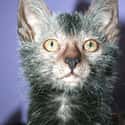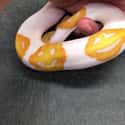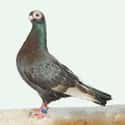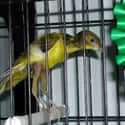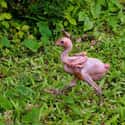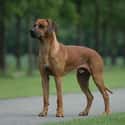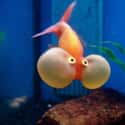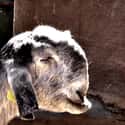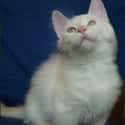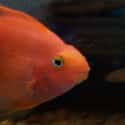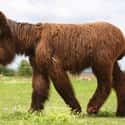-
(#1) Lykoi Cats Look Like Lycanthropes
The origin of lykoi cats is a bit of a mystery. These cats are popular because they look like mini werewolves, which is how it got its nickname the "Werewolf Cat." The gene responsible for the werewolf-like appearance of lykoi cats appears to have developed on its own. The particular pattern of baldness is a genetic mutation unrelated to that of a sphynx cat. Now, breeders are actively trying to popularize the mutation and as of May 2017, Lykoi cats can be shown in The International Cat Association shows under Championship status.
-
(#2) The Emoji Python Is Always Smiling
Why have a normal snake pattern when you could have a snake covered in smiley faces? Justin Kobylka, a snake breeder, spent eight years breeding this snake to have its unique smiley-face pattern. The snake's coloring is normal for an albino ball python, but breeding it to have three complete smiley faces on its back took time and effort. The pattern is a mere cosmetic difference and confers no benefit or harm, other than that all of Kobylka's hard work in breeding the snake means it's worth over $4,000.
-
(#3) The Budapest Short-Faced Tumbler Certainly Earns Its Name
The Budapest short-faced tumbler has an apt name. Its face, especially in comparison to its large eyes, is quite small. Its beak is also considerably smaller, which can lead to feeding and hatching problems for young birds. Initially bred to fly higher than the average pigeon, the Budapest short-faced tumbler has since become a fancy breed usually reserved for showing. Raising them is a tough gig for breeders, as they often require hand feeding and may experience a variety of health problems due to generations of breeding with small populations.
-
(#4) This Bird Is Bred To Look Like The Number Seven
The gibber italicus canary looks more like a cartoon vulture than its cute yellow origin. Deliberately bred for its bizarre posture, which ideally makes it look like the number seven, this canary breed has sparse feathers and a nervous disposition that makes it ill-suited as a pet for anybody but expert breeders. This canary variant was produced after years of inbreeding to create its strange shape and feathers. While some selective breeding experiments can be cute, this one is more than a little bit creepy. What's even creepier is that its unclear why canary enthusiasts wanted to make this bird in the first place.
-
(#5) A Scaleless Chicken Is Convenient For Poultry Industry, Creepy For Everyone Else
Ever wanted a chicken without all those pesky feathers? You're in luck, because the scaleless chicken exists. Scaleless chickens look like a regular chicken that's already been plucked and boiled, which is actually beneficial to the poultry industry. Featherless birds are easier to climate control and don't require plucking. The downside? They easily catch parasites and are more difficult to breed because of an inability to flap their wings. Their creepy appearance is just a side effect.
-
(#6) Rhodesian Ridgebacks Are Bred To Hunt Lions
The Rhodesian ridgeback is impressive on first glance, and for good reason - the breed was developed to help hunt animals in Africa, including large animals like lions and bears. Hunters noticed that dogs with the characteristic ridge of hair along their back were typically better hunters, and selective breeding with good hunting dogs led to the breed we have today. Unfortunately, as with many purebred dogs, the Ridgeback is prone to a slew of medical issues like hip and elbow dysplasia, as well as certain disorders of the spine.
-
(#7) A Goldfish With A Dangerous, Selectively-Bred Trait
The bubble-eye goldfish is a product of selective breeding that make just about everybody ask, "Why?" This variety of fancy goldfish has two water-filled bladders underneath its eyes, which force the goldfish to always look upward. And these bladders aren't sturdy - they can be easily punctured in a tank or even sucked into a filter, opening them up to potential infection. Their cosmetic differences from other fish are more of a hindrance to the fish than a positive trait. The bladders make it difficult to see and pose an infection risk.
-
(#8) The Most Beautiful Ugly Goat In The World
Goats are cute, right? While the Damascene goat may not be your particular breed of cute, they're often voted as the most beautiful in competitions, with their sloped faces and droopy lips considered desirable traits. Damascene goats are bred for their milk and meat, and are often crossbred with other varieties. And unlike many other animals on this list, their strange appearance has no negative effects on them - though they look odd, they're healthy, useful, and even-tempered, making them great pets or livestock.
-
(#9) Munchkin Cats Take Cuteness Too Far
It's tempting to take something cute and make it even cuter, but sometimes that backfires. Munchkin cats are one such example. While their large eyes, long fur, and short, stubby legs make them the epitome of precious, these cats are selective bred for dwarfism, which causes their short legs. It also causes the cats to have spinal malformations, limits how much (and how high) they can jump, and leads to a slew of medical problems.
Because munchkin cats are a relatively new breed, there hasn't been much research into whether their lack of ability to jump is due to reduced leg size or because it's painful for them, leading to questions about how ethical it is to breed them for cuteness. In 1995, members of the International Cat Association had a huge blowout over the cats, with some saying they are the cats of the future and others saying they're a cruel creation.
-
(#10) Blood Parrot Cichlids Are Slightly Less Terrifying Than They Sound
What happens when you combine two South American cichlids and mash them together? You create the blood parrot chichlid, a variety of fish bred to have a bright and colorful appearance. Unfortunately, blood parrots are also the subject of some controversy - selective breeding has given them a small vertical mouth that can make it difficult for them to chew. Though they can crush food with their throats, fish lovers have raised concerns that breeding a creature that can't eat effectively is unethical, leading to protests of shops that carry blood parrots.
-

(#11) These Giant, Wrinkly Dogs Are The Result Of Years Of Selective Breeding
Want a dog that looks something like a kindly old man? You're in luck, because thanks to selective breeding, the Korean mastiff, or Mee Kyun Dosa, exists. These dogs are huge, wrinkly, and gentle, inbred specifically for their rich coat coloring. Their great personalities and striking appearance are a draw for fans of the breed, but unfortunately those years of inbreeding have led to a number of genetic health conditions, such as cherry eye, hip dysplasia, and other issues.
-
(#12) These Werewolf Skinny Pigs Don't Howl At The Moon
Hairless, werewolf-inspired creatures are a bit of a hit among selective breeders. The trend also appears in guinea pigs, where they are bred to have no hair, and called "skinny pigs." Those that regrow hair after they're born are called werewolf skinny pigs because of their patchy appearance. Werewolf and other varieties of skinny pigs need extra care to prevent overheating, but are otherwise just as healthy and active as other guinea pigs.
-
(#13) Poitou Donkeys Almost Died Out
The poitou donkey is a unique creature - after centuries of breeding these massive, dreadlocked donkeys for their size and strength, their popularity began to dwindle. Machines replaced animals for farm work and there was less need for them, and in 1977, there were less than 50 remaining. Now conservationists are trying to revive the poitou donkey population.
-
(#14) West Highland White Terrier
- Animal breed
Westies - officially called west highland white terriers - are a beloved dog to many. But the history of these creatures is a little less wholesome. The dog comes from a breeding program in the early 20th century Scotland. Edward Donald Malcolm created this breed by crossing Scottish terriers and Polatalloch terriers.
Unlike other dogs who are a result of selective breeding, westies actually quite low maintenance dogs - which is why they're a favorite pet for elderly people. They do have some typical medical issues associated with selective breeding: hip dysplasia, cleft palate, and carniomandibular osteopathy, to name a few.
New Random Displays Display All By Ranking
About This Tool
Selective breeding is the process by which humans control the reproduction of animals according to their own purposes. Select individuals with special traits that can be inherited to mate, thereby establishing breeding varieties with popular traits. Domestic dogs, sheep, and horses are all bred in this way. In addition to physical characteristics such as fur color, horn shape, etc., traits also include other physiological factors, such as egg and milk production and behavior.
It is not only used in agriculture and animal husbandry production, selective breeding is also helpful to genetics research. Here the random tool introduced 14 strange animals in real life that are the result of selective breeding.
Our data comes from Ranker, If you want to participate in the ranking of items displayed on this page, please click here.










